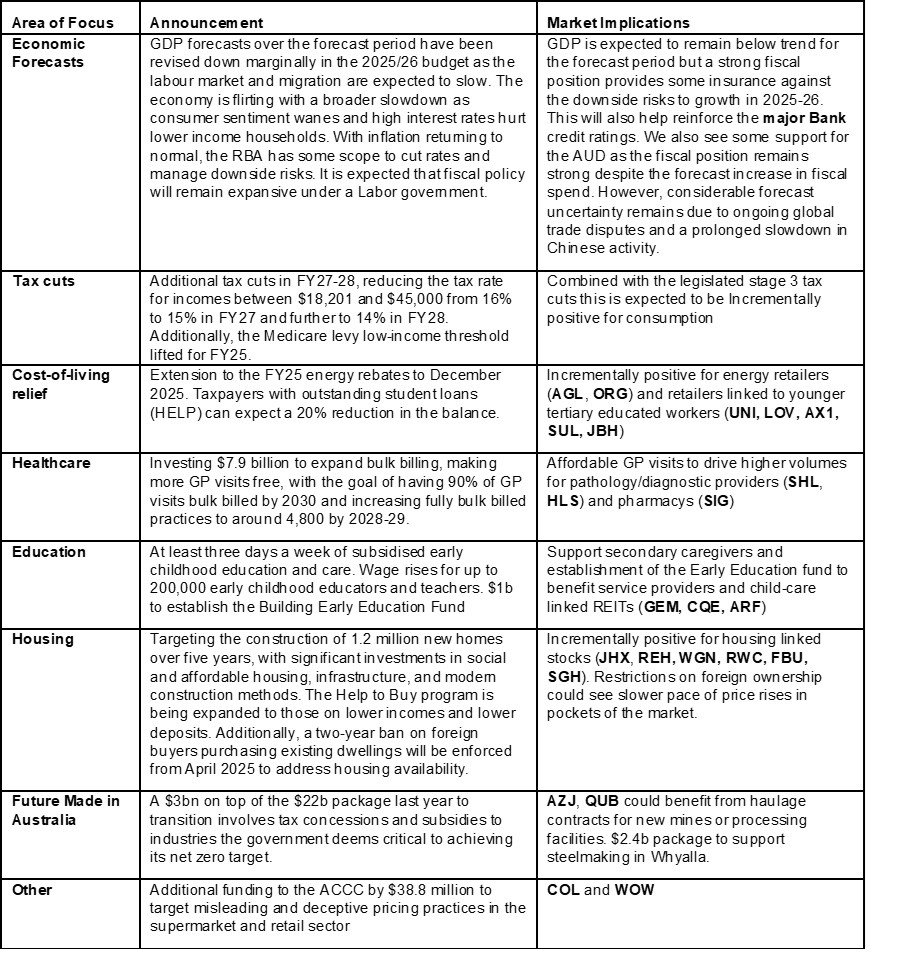Investment Watch: Summer 2026 Outlook
Investment Watch is a quarterly publication delivering insights into equity strategy and economic trends. The Summer 2026 edition explores global and Australian growth outlooks, structural shifts in asset allocation, and highlights opportunities across AI, resources, property, and income strategies to help investors navigate volatility and prosper in the year ahead.
Investment Watch is a quarterly publication produced by Morgans that delves into key insights for equity and economic strategy.
This publication covers
Economics - 'The Australian economy: a landscape of challenge and opportunity'
Asset Allocation - 'Structural shifts demand a portfolio rethink'
Equity Strategy - 'Diversification is key'
Banks - 'Fundamentals don't justify share price strength'
Industrials - 'Prepared for the uptick'
Travel - 'Selective opportunities'
Resources and Energy - 'Steady China and tight supply'
Consumer discretionary - 'Recovery underway'
Healthcare - 'Attractive, but with limited opportunities'
Infrastructure - 'Rising cost of capital but resilient operations'
Property - 'Structural tailwinds building'
It’s hard to believe that 2025 is already drawing to a close. As we enter the holiday season, we want to take a moment to express our deepest gratitude for your continued support and trust. This trust is the very foundation of everything we do. This time of year is a chance to reflect on the significant progress we’ve made. The entire team at Morgans is incredibly proud of the efforts and achievements from the past twelve months that reinforce our commitment to providing you with top-tier advice and opportunities. These achievements mean that Morgans continues to provide top-line advice and investment opportunities that benefit clients across our national branch network.
Morgans clients receive exclusive insights such as access to our latest Investment Watch publication. Contact us today to begin your journey with Morgans.
Morgans Financial's Chief Economist and Director of Strategy, Michael Knox, discusses President Trump's introduction of reciprocal tariffs to address high foreign tariffs on U.S. goods. Learn how this policy aims to balance trade and reduce the U.S. budget deficit, impacting countries like China, the EU, Vietnam, and Australia. Read the transcription below:
"Back in November, we began discussing a policy document written by Peter Navarro, who had outlined what he expected the Trump administration to achieve if it were elected. One key part of this policy involved reciprocal trade, which aimed to address the issue of high tariffs charged by other countries on imports of U.S. goods. The idea was to create a structure for negotiating down these tariffs.
Navarro argued that many countries were imposing very high tariffs on U.S. imports, and the goal was to bring these rates into alignment with those that the U.S. imposes on goods from those countries. Fast forward several months. This week, President Trump issued an executive order that introduced these reciprocal tariffs. Essentially, the idea is that the U.S. will impose tariffs on other countries promted by the tariffs they charge on U.S. goods. For example, countries like Vietnam or China charge significantly higher tariffs on American goods than the U.S. charges on imports from these countries. The U.S. proposal is to raise its tariffs to match half the rates charged by these countries.
For instance, China currently imposes a 67% tariff on American goods, while the U.S. only charges about 2.5%. Under the new proposal, the U.S. would raise its tariffs on Chinese goods to 34%, which is half of the Chinese tariff. Similarly, the European Union charges about a 39% tariff on U.S. goods, and the U.S. now plans to charge 20% on imports from the EU. Vietnam, which imposes around a 90% tariff, would see U.S. tariffs rise to 46% . Taiwan, which has a tariff of 64%, would be subject to a 32% tariff.
Australia, however, fares better with only a 10% tariff on U.S. goods. Some have questioned why Australia faces this tariff despite not charging any tariffs on American imports. The reason, according to Navarro, is that Australia's Goods and Services Tax (GST) is 10%, which, while not a tariff, effectively raises the price of imported goods in the same way that tariffs do. Therefore, it is treated similarly to an import tariff.
Although this concept of reciprocal tariffs has been discussed since November, it came as a surprise to many countries when Trump made the announcement in the Rose Garden this week. For some nations, like Australia, the 10% tariff may be the best deal available. This is because the U.S. is aiming to reduce its budget deficit, which is currently running at about 6.8% of GDP. Part of this effort involves raising revenue through tariffs. The U.S. hopes to reduce its deficit to about 3% by cutting spending and increasing revenue.
Ultimately, the goal of these reciprocal tariffs is to create a bargaining process where other countries can negotiate lower tariffs. As the market adjusts to this idea, we expect the situation to stabilise. Over the coming weeks, there may be more clarity on how these tariffs will be applied and whether countries can reach agreements to reduce them to more reasonable levels. The market has already reacted dramatically to the news, but as this process unfolds, it’s likely that the global economy will adapt to the changes, and the financial system will settle down."
In a recent radio interview, Michael Knox, Chief Economist and Director of Strategy at Morgans, shared his perspective on Australia's economic trajectory. Knox highlighted concerns about the country's increasing debt and reliance on foreign borrowing, suggesting that Australia is spending beyond its means. Read the transcript below:
Knox:
"Well, Australia looks like it's a country that's spending more money than it has, and it’s financing that by foreign borrowing. That's what it looks like to me. I’m looking at a wonderful document, which is the sales document that goes with the budget parties, called Building Australia’s Future.
I'm not focused on the text; I'm looking at all the appendices at the end. When I do that, I find that Australia’s debt from 2024/2025, out to 2028/2029, is expected to grow by $283 billion, from $940 billion to $1.223 trillion. Net debt is expected to grow by a little less than that, as our foreign investments are improving, which brings it to $212 billion. So, that seems to be something for future generations to deal with. The money appears to be coming from those nice people who go to Davos.
A couple of years ago, we were running a current account surplus, and we were often running a trade surplus. But now, we’re running a current account deficit. This was way back when commodity prices werethe best ever in Australian history, and that’s when Jim Chalmers made 'the biggest ever fiscal improvement' by running a balanced budget with a narrow surplus.
Now we have the dividends of this 'responsible economic management'. However, when I look at what’s happening, we’re seeing a current account balance that’s getting worse every year for the next four years. The outcome last year was a deficit of 1.3%, and by the time we get to 2025–2026, this deficit is projected to blow out to 3.75%, and by 2026–2027, it will be even worse, with a current account deficit of over 4%.
So, where is this growth coming from? It's driven by public spending, financed by all those nice people at Davos who are lending us money, increasing Australia's foreign debt."
Austin:
"My guest is Michael Knox, chief economist at Morgans. Bob Katter, a long-standing federal politician, says the 2025 budget reveals a government more focused on reactive policies than proactively addressing the needs of our nation. Is he right?"
Knox:
"Well, we've got a government here that seems to be focused entirely on the most important thing in the world for them: getting re-elected. What we’re seeing is a lot of spending in the current year, 2024–2025, with public final demand increasing by 5%, while private demand is only growing at 1%. The normal growth rate would be around 2%.
So, there’s a blowout in public spending, which, I’m sure, is carefully targeted at interest groups selected through political research. As a result, this is generating a deficit and more debt. The crucial objective here is that the government wants to get re-elected."
Austin:
"Dr. Jim Chalmers did his doctorate on Paul Keating's government 39 years ago. Paul Keating once said, "If you're not hitting 4%, you're not even trying," and he warned that, if we weren’t careful, we’d become a banana republic. Do the debt figures from the appendices of the federal budget suggest that we are acting like a 'banana republic', as Paul Keating warned nearly four decades ago?
When I look at this deterioration of the current account, from 1.3% of GDP in the year just past (2023/2024), blowing out to 4.25% for the current account deficit in 2027/2028, it seems that Paul Keating would recognise this as delightfully South American."
Austin:
"Michael Knox, thank you very much for your time."
Listen the full interview here.
Celebrating Two Decades of Impact with the Morgans Foundation
Established in 2005, the Morgans Foundation has donated over $20 million to charities across Australia. This unwavering commitment to philanthropy has been a cornerstone of Morgans Financial Limited's mission to give back to the community.
Empowering Communities
For 20 years the Foundation has been a steadfast supporter raising funds and awareness for numerous charities.
The Foundation's support extends to a diverse range of causes, from health and education to social welfare and the arts. By partnering with local Morgans branches, the Foundation ensures that support reaches grassroots initiatives, addressing specific community needs and fostering a culture of giving among employees and clients alike.
Commitment to Rural and Regional Communities
Furthermore, Big Dry Friday our annual charity initiative has raised over $8 million in eight years and supports rural communities affected by drought pressing issues, providing much-needed relief and support to those facing challenging times. Beneficiaries include, Rural Aid, Outback Futures, Schools Plus and Royal Flying Doctor Service.
Employee Engagement
Central to the Foundation's philosophy is the active involvement of Morgans' employees. In 2024 alone, over 150 employees volunteered their time and skills, embodying the spirit of community service and enhancing the impact of the Foundation's initiatives.
Looking Ahead
As we celebrate this 20-year milestone, we remain committed in our mission to support and uplift Australian communities. With a continued focus on collaboration, responsiveness, and impactful giving, we look forward to the next chapter.
For more information about the Morgans Foundation and our initiatives, visit Morgans Foundation.
Staking it all on tax cuts and cost-of-living relief
The government largely pre-announced the 2025-26 Federal Budget over the past week. Handing down a deficit in 2024-25 and delivering further cost-of-living relief. The government did keep a tax cut up its sleeve and announced a reduction in the tax rate for all taxpayers. While there's a little bit for everyone, the forecast deficits for the next four years limit the government's ability to push harder on spending. Still, there's no denying this is a pre-election budget designed to appeal to the mainstream voter by putting spending ahead of saving.
Treasurer Jim Chalmers' fourth Budget shows the government is on track to achieve a budget deficit of $27.6bn, a slight deterioration from MYEFO that predicted a $26.9bn deficit. A range of upside surprises again drove revenue (the strong labour market, strong wage growth, and net overseas migration) but was offset by higher-than-forecast spending.
The key announcements were tax cuts, the extension of the energy rebates, GP bulk-billing funding and further support for the "Future Made in Australia" program. However, there has been no meaningful attempt to tackle structural pressures from NDIS, aged care, and health care, which has seen growth outpace inflation over the past few years.
Ahead of the election, this was the last chance for the government to demonstrate their economic credentials. Without meaningful reform, a helping hand from commodity prices, and a strong labour market, this Budget was underwhelming from a market perspective. In summary, the measures announced today will unlikely move the dial on market sentiment.
And there goes the surplus – The Budget swings back into a deficit in FY25 (-1.0% of GDP), which is forecast to remain over the forecast period (FY26-FY29). Deficits are expected over forward estimates as commodity prices ease and unemployment set to rise. Also, extra spending commitments (tax cuts, changes to Medicare and changes to education) will weaken the fiscal position over the forecast period. The capacity for the economy to absorb higher interest repayments will be tested over the next few years if government revenue declines as economic conditions deteriorate as expected.

Treasury's forecast for gross debt rises from A$940b in 2024-25 (33.7% of GDP) to peak at A$1,161b in 2027-28 (36.9% of GDP). However, Australia's fiscal position remains well below peers global peers, which reinforces the highest possible sovereign credit rating.
World Gross Debt-to-GDP (IMF Forecasts and Treasury Estimates)

• Mildly inflationary but no big deal for equity markets – taking everything into account, a surprise tax cut, a bump in government spending, and some targeted measures to address cost-of-living pressure should not worry investors. Importantly for the market, a strong fiscal position and few inflation-inducing spending measures should also reassure investors that a slowdown is possible without a recession.
• A few more consumption levers were pulled this year ahead of the election – As anticipated, an extension to the energy rebates and changes bulk-billing and Medicare were announced. The government also surprised us by announcing a tax cut for all taxpayers, with the average worker expected to save $268 in FY27 and $536 in FY28. It also announced support for students with outstanding HELP debt by reducing the balance by 20%. All considered, the measures incrementally support consumption and sentiment.
• Budget assumptions and a cut expected to net overseas migration – Forecasts provide a low hurdle for the December MYEFO and next year's Budget. Key commodities are assumed to decline from elevated levels with iron ore price assumed to decline from US$101/tonne to US$60/tonne by March 2026; the metallurgical coal spot price declines from US$188 to US$140/tonne; the thermal coal spot price declines from US$97 to US$70/tonne. The AUD is expected to remain at 62c through the forecast period. The Budget expects net overseas migration to be 335,000 this year, after 435,000 last year. The government forecasts that it will fall to 260,000 in FY26, to 225,000 in the following years. Notably the RBA cash rate is assumed to fall a further 50bps in 2025.

Our thoughts
The quest for re-election is staked on the success of this Budget. Labor's fourth attempt put aside fiscal restraint and delivered a suite of spending promises. It was clearly designed to appeal to the mainstream voter by putting tax cuts front and centre promising something for every taxpayer. Changes to Medicare and some cost-of-living relief will provide some support for domestic demand, which in our view is mildly inflationary but unlikely to move the dial meaningfully on corporate profitability.
Successive governments have lacked the determination to bring about significant structural reform, chiefly around genuine tax reform, productivity and housing. This Budget is no different. The lack of genuine long-term reform through a period when the federal balance sheet has been boosted by elevated tax revenues, a strong job market and higher than expected commodity revenue is a missed opportunity for Labor.
In our view, the Budget is unlikely to bring about significant revisions to corporate earnings, however the ongoing commitment to support the vulnerable parts of the economy should help market sentiment and support earnings confidence. We prefer a targeted portfolio approach favouring quality (strong cashflow and market position e.g. JHX, DBI, QBE, CSL), and select cyclicals (QAL, UNI, ALQ, ORI, BHP). See our Best Ideas for our most preferred exposures.
Morgans clients receive access to detailed market analysis and insights, provided by our award-winning research team. Begin your journey with Morgans today to view the exclusive coverage.
It is easy to become distracted by the current affairs occurring both domestically and overseas. From the upcoming federal election to Trump tariffs, the Ukraine/Russia war and so much more, there’s just too much to keep up with for any sane person.
With everything going on, it's important we try to maintain other, more 'normal' aspects of life. Things we can control, such as our end of financial year tax planning. What do you need to do to get your financial house in order before 30 June?
Here are some handy hints for you to consider over the next few months, contact your adviser to chat about any of the following topics:

Investment, Property, and Insurance
Have you sold an investment asset this financial year? Ensure you have copies of your investment statements, including dividend statements. This is also a good time to review your investment portfolio. Markets have been quite volatile recently, so there may be opportunities you can take advantage of, such as capital gains/losses. If you own property, make sure you have your paperwork up to date, particularly if you can claim depreciation. Additionally, ensure your personal insurance, including life and income protection insurance, is in order. Has your personal situation changed? Talk to your Morgans adviser about a portfolio administration service that will make next year’s paperwork and tax time simple.

Retirement and Superannuation
Are you thinking about retiring this year? Ensure you have your details to access your Super or other retirement income stream. Review your capital gains and losses for your investment and superannuation portfolios. Consider what superannuation contributions you have already made or intend to make prior to 30 June. Talk to your financial adviser to ensure you understand what contribution limits apply to you. If you are already receiving a pension from your superannuation, make sure you meet your minimum pension requirements before 30 June to avoid significant penalties. Talk to your adviser to identify investment and superannuation strategies you can put in place before 30 June to help protect your retirement savings.

What the superannuation thresholds for 2025-2026 means for you
From 1 July 2025, the transfer balance cap will index from $1.9 million to $2.0 million, allowing individuals to transfer more into their retirement phase accounts. Similarly, the total super balance cap will index to $2.0 million from 30 June 2025. Concessional contributions will remain at $30,000 per person per annum, while non-concessional contributions will stay at $120,000 per person per annum, with the option to bring forward up to $360,000 over three years for eligible individuals, depending on their total super balance as of the previous 30 June. Additionally, the Super Guarantee Charge (SGC) rate will increase from 11.5% to 12% for the 2025/26 financial year, marking the final planned increase to the SGC rate. These changes provide opportunities to maximise your superannuation contributions and benefits, so it's important to plan accordingly and consult with your financial adviser.
Will you be ready?
Don't let global issues distract you from the things you would normally focus on at this time of year. It's time to get back on track.
Feel free to contact your Morgans adviser to discuss your end of financial year planning.
Everybody has heard the saying, “If you seek peace, prepare for war.” That was said by a guy called Vergetius who lived in 390 AD. There was someone else more recently, his name was Winston Spence Churchill. He said, “it is important to understand that the United States is essentially a naval power”. He made this comment in the first volume of his history of the Second World War. If we consider the current military situation, particularly the risks in the Pacific, a good starting point is a speech by Admiral John Aquilino US Commander of the Indo Pacific Fleet to the US Senate in March 2024.
Admiral Aquilino said that the most dangerous national security challenges are evolving faster than the current government processes can address them. Each of the three major state threats— the People's Republic of China, Russia, and the Democratic People's Republic of Korea—are taking unprecedented actions to challenge international norms and advance authoritarianism. These regimes are becoming increasingly interconnected, as evidenced by Xi Jinping and Vladimir Putin's "no limits" friendship and Kim Jong Un’s materiel support of Putin’s illegal invasion of Ukraine. Despite this, China is the only country with the capability, capacity, and intent to fundamentally alter the international order, even amidst its slowing economic growth.''
Aquilino continued "China continues its aggressive military buildup, modernisation, and coercive grey-zone operations. All signs point to the People's Liberation Army following President Xi’s directive to be ready to invade Taiwan by 2027. The recent actions taken by China also indicate their preparedness to meet Xi’s timeline for the unification of Taiwan with mainland China by force if directed."
One of the results of this growing military capability is the rapid pace at which China is building ships, surpassing the US in this area. This has led to the introduction of a bipartisan bill in the US Senate called the “Ships for America Act,” which was introduced to the Senate on December 19, 2024.
The Act outlines that strategic sealift, made up of government and commercial vessels, is a critical capacity for executing the United States' maritime defence strategy during both peacetime and wartime. On March 4, just a few days ago, US President Donald Trump said in a speech to the US Congress, among many other things, he said" We will create a new Office of Ship Building in the White House and offer special tax incentives to bring this in industry home to America “. In his first term, Trump attempted to rebuild US manufacturing of steel and aluminium to support military construction, imposing a 10% tariff on these materials.
This move led to a significant increase in domestic production of steel and aluminium. However, during the Biden administration, waivers were issued, allowing the US to import steel and aluminium. This led to a decline in domestic production. In response, Trump has now proposed a 20% tariff on these metals in a bid to revitalise the shipbuilding industry. So, the point of that is to rebuild the US ship building industry so the US can defend our parts of the Pacific as well as other parts of the Pacific as well.
Looking ahead, there is a narrative circulating due to the falling stock market that the US economy is heading into recession. However, the evidence does not support this claim. Last year, the US economy grew by 2.9%, and while growth is expected to slow, this is due to the Federal Reserve raising interest rates to curb inflation. As inflation begins to decline, the Fed will likely reduce rates again, leading to a projected growth rate of 2.3% this year and 2% next year.
In contrast, the Euro area grew at just 0.7% last year, but it is expected to grow at a faster pace—around 1.1% this year and 1.4% next year, maybe even faster. This growth will be driven by a significant increase in domestic manufacturing in Europe. One important outcome is now that German interest rates are rising relative to US rates, particularly at the longer end of the yield curve. This has contributed to the strengthening of the Euro and a corresponding decline in the US dollar.
We expect further downside pressure on the US dollar. As the dollar weakens over the coming year, commodity prices are likely to rise. Our model of Australian export prices for commodities is based on two key factors: variations in the US budget deficit and the level of international liquidity used to finance global trade. This liquidity is measured by Total International Reserves, updated quarterly by the International Monetary Fund (IMF).
In recent years, the growth rate of international reserves has been the lowest since the early 1980s, leading to a slump in commodity prices. However, International Reserve growth rate is now accelerating again, and as reserves increase, commodity prices are expected to recover. This will result in a gradual rise in commodity prices, lifting them above the levels seen in 2015, 2016, or 2017.
Looking at the rate of change in international reserves, we can see that the recent low growth observed in 2022 is now rebounding. This acceleration is already back to its median growth rate of around 7% and will eventually reach the historical average of 9.7%. This will help support the recovery of commodity prices in global markets.
Regarding the US economy, our model, which tracks a broad index of economic activity called the Chicago Fed National Activity Index, has been highly reliable over the past 30 years. The Federal Reserve’s goal was to slow economic growth to allow inflation to fall, and it has been successful in doing so. With solid, sustainable growth of around 2% expected in the US economy, the reports of the demise of the US economy appear to be exaggerated.
However, the US government faces a significant challenge with the rising level of national debt. Unfortunately, the US debt-to-GDP ratio has risen to a point where the cost of rolling over its debt now exceeds military spending. this poses a danger to the country’s long-term security.
The great thing about gold is that it holds its value over long periods of time. Right now, it’s higher than our model suggests. However, what usually happens when it reaches this kind of level is that it builds a top for a long period. Silver is cheap right now because it always follows gold.
When it comes to currencies, the U.S. budget deficit, plays a significant role. Similarly, the budget deficit in the Eurozone is another factor that influences currencies. Additionally, short-term interest rates are important, but it’s really the long-term interest rates—such as ten-year bond yields—that matter most.
On 28th February, our model suggested that the Euro should be trading significantly higher than it was at $1.04, and it did exactly what the model predicted. Since then, the Euro has lifted dramatically. Based on the latest run of the model, the Euro is expected to rise further to around $1.20 within the next three months.
This suggests that the U.S. dollar is beginning to fall, which sets the stage for a rally in commodity prices.
When it comes to the Australian dollar, our commodity price model suggests it should be a bit higher, although interest rates and inflation targeting are more relevant to the U.S. Federal Reserve's (Fed) policy.
The Fed has room to cut rates, whereas the Reserve Bank of Australia (RBA) does not.
There has been speculation around China holding all U.S. Treasury bonds and potentially destabilising the U.S. Treasury market by selling them off. However, since 2013, China has aggressively sold down the U.S. bonds it held. Back in 2013, China was the biggest holder of U.S. Treasury bonds, but now Japan is the largest holder, followed by the U.K. The question then arises: why would the U.K. hold U.S. Treasuries? The U.K. has the largest international banking sector in the world, and its banking system generates most of the international value and export services for the U.K. economy.
It’s not that the U.K. government is holding these bonds, but rather the U.K. banking system is holding them on behalf of a range of international investors. After the U.K., countries like Japan and smaller ones, such as Luxembourg and Canada, hold U.S. Treasury bonds. Canada, for example, holds these bonds due to its banks' interactions with the U.S. banking system. The Cayman Islands also hold a significant number of U.S. Treasury bonds, with their large industry and manufacturing sectors. So, the notion that China holds all the U.S. bonds and can destabilise the market is no longer true. In fact, China sold off many of those bonds years ago.
Morgans clients receive access to detailed market analysis and insights, provided by our award-winning research team. Begin your journey with Morgans today to view the exclusive coverage.













